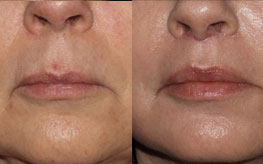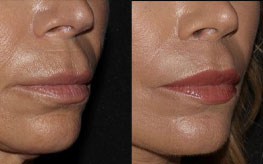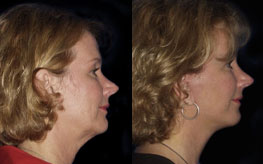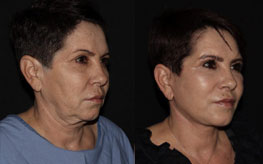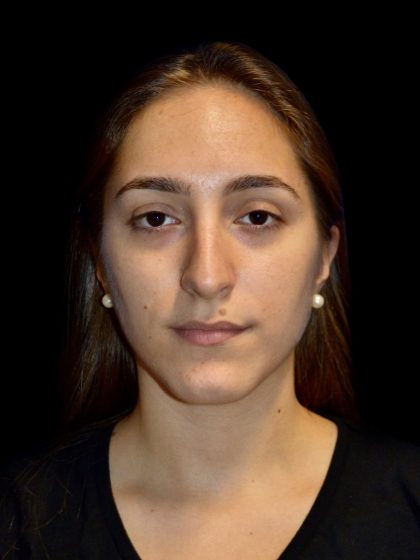Dorsal Hump Reduction
Conveniently located to serve the areas of San Diego, CA
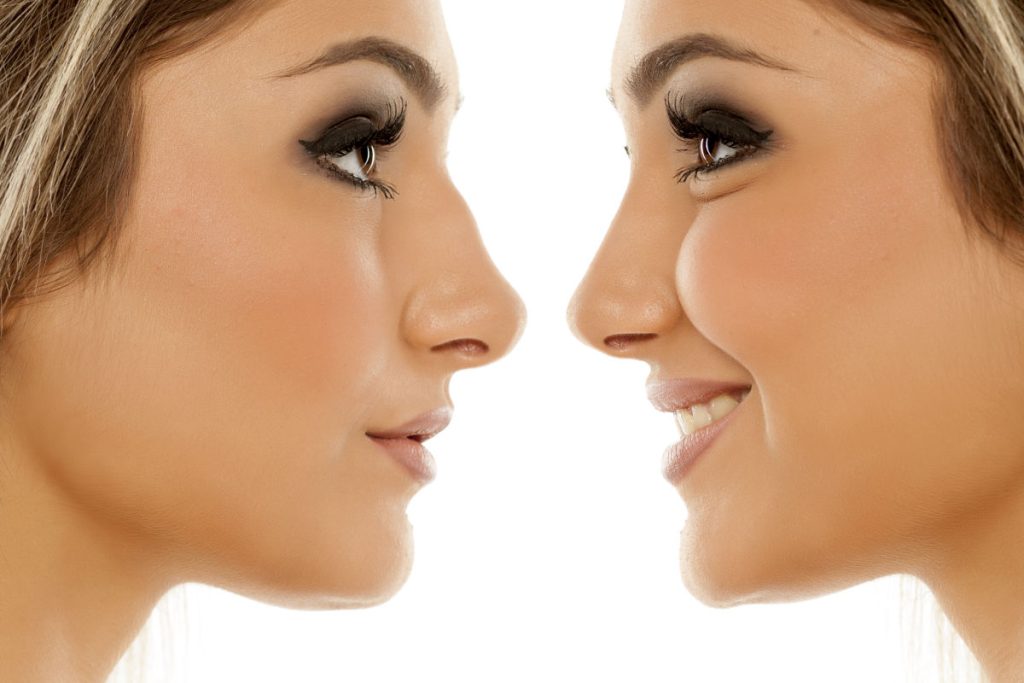
Dorsal hump reduction is a surgical technique used to remove bony irregularities on the bridge of the nose during rhinoplasty, highly impacting its resulting shape and contour. Smoothing this section of the nose provides patients with aesthetically pleasing silhouettes, helping patients achieve their desired aesthetic goals while maintaining harmony with the rest of their facial structures. If you have always been unhappy with the bump in the middle of your nasal profile, dorsal hump reduction could be your solution.
As two of San Diego’s leading plastic surgeons, Dr. John T. Alexander II and Dr. Jordan Kaplan perform many life-changing surgeries for their patients, including rhinoplasty, enabling patients to envision the nose they have always wanted.
Alexander Cosmetic Surgery offers a wide array of aesthetic procedures that are specifically tailored toward each patient. To schedule a consultation today, fill out our simple contact form. Take the first step toward your dream nose and contact us directly at (858) 455-7557.
Contents
Before and After Photos
What is a Dorsal Hump?
The bridge of the nose is made up of bone and cartilage. No two noses are the same, and some people have a more pronounced hump that interrupts the slope between the eyebrow ridge and the tip of the nose. The prominence of a dorsal hump can vary in size and shape, and the trait is often genetic, but it can also occur due to trauma or severe infection. Although a dorsal hump does not typically affect breathing, its presence may be distressing for some patients. By addressing this protuberance and refining the nasal bridge, patients can achieve a smoother, more aesthetically pleasing nasal profile through rhinoplasty.
Dorsal Hump Reduction Techniques
Rhinoplasty procedures frequently include an osteotomy to remove bone and cartilage from the nasal bridge. The bridge can be shaved down or cut to reduce protruding portions, making this a vital step toward a visually pleasing nasal profile. (1) When included during rhinoplasty, this step shaves down or removes the hump laterally. This can be done during both open and closed rhinoplasty. (2)
Open Rhinoplasty
Open rhinoplasty allows better visibility during surgery. An incision between the two nostrils ensures the surgeon can lift the skin, revealing the underlying structures of the nose. They can then remove the dorsal hump with more ease. Open rhinoplasty is an effective approach for more complicated rhinoplasty cases. If your dorsal hump is severe or highly irregular, your surgeon may choose to use this technique to achieve the best result. (3)
Closed Rhinoplasty
During closed rhinoplasty, the surgeon utilizes internal incisions only to access the inner anatomy of the nose. By incising through the nostrils, they separate the skin from the underlying structures, operating through the small opening without the need to lift the skin. This approach causes less scarring and swelling but limits a surgeon’s visibility.
If your dorsal hump is minimal, a closed rhinoplasty may keep your surgery time short and your scarring minimal. It is usually reserved for patients in need of minor revision. (3)
Benefits of Dorsal Hump Reduction
A noticeable dorsal hump can negatively affect a patient’s self-esteem. It can make their nose look crooked or bumpy, taking attention away from the rest of the face.
Dorsal hump reduction can help patients achieve:
- A straighter nasal profile
- A narrower bridge
- Improved overall nasal shape
This procedure can also improve both your self-image and perception, especially if you have found your nasal bump to be distracting or unattractive.
Ideal Candidates for Dorsal Hump Reduction
The ideal candidate for this procedure is in good overall health with the desire to undergo rhinoplasty. Dorsal humps come in many shapes and sizes, so consider what your ideal nose contour looks like before meeting with us.
If you have any of the following attributes, dorsal hump reduction can resolve them:
- Noticeable hump
- Uneven nasal bridge
- Wide bridge width
- Nasal asymmetry
- Unsatisfactory nose size
If you are receiving a revision rhinoplasty, your nose must be completely healed before receiving your second surgery to avoid complications.
Personal Consultation
When you meet with us to talk about your rhinoplasty, we will ask you specific questions about your nasal concerns. The consultation gives you time to learn all you need to know before your surgery date. Dr. Alexander or Dr. Kaplan will perform an examination to determine the most effective surgical technique to reduce your dorsal hump. Potential candidates should have reasonable expectations before undergoing surgery. Rhinoplasty is an incredibly intricate procedure and you must be aware of all potential outcomes.
At Alexander Cosmetic Surgery, we take great pride in providing personable and professional care for every patient. Our surgeons take the time to understand your cosmetic goals and personal preferences to sculpt the nose to achieve a harmonious and natural appearance.
Preparation
- Stop Smoking: If you are a smoker, you must quit before your procedure, and for the duration of your recovery. Nicotine and other chemicals in tobacco products increase the risk of infection and postoperative complications.
- Review Your Medications: Avoid taking blood thinning medications like aspirin and ibuprofen for 2 weeks, and inform your surgeon of all of the medications you are currently taking.
- Organize Transportation: Arrange for a family member or friend to drive you to and from our facility, as you will not be able to drive after your procedure because of the effects of anesthesia.
- Medication Pick-Up: Fill any prescriptions you will need during your recovery ahead of time.
Dorsal Hump Reduction Procedure
We will administer anesthesia to keep you comfortable during your procedure. At Alexander Cosmetic Surgery, we provide patients with a range of anesthesia options tailored to their preferences, individuality, and the intricacy of their surgery. The procedure starts with incisions according to your treatment plan, using either an open or closed approach. Whether it involves cartilage sculpting, bone recontouring, or a combination of techniques, the goal remains consistent – to achieve a natural-looking and proportionate nasal appearance.
Bony Vault Osteotomy
Where necessary, your surgeon will perform an osteotomy to the bony vault (nasal bridge). There are two main techniques commonly used; the external perforating approach and the internal continuous technique. With the use of an osteotome (a surgical chisel beveled on both sides), your surgeon removes sections of cartilage and bone carefully to smooth the hump. (4)
After he has made all the necessary corrections to the nose, the surgeon sutures the incisions and fits the nose with splints and a cast to keep it structurally sound while healing. Rhinoplasty can take anywhere from 2 to 4 hours depending on the extent of the surgery and what alterations must be done for the patient.
Rhinoplasty Recovery
- Managing Swelling: Swelling is a natural part of the healing process post-rhinoplasty. Initially, swelling is more pronounced but gradually subsides over time. Elevating your head while resting can help minimize it.
- Bruising: Bruising around the eyes and nose is common after rhinoplasty. This discoloration typically resolves within a couple of weeks as your body heals.
- Pain Management: Discomfort and mild pain are normal after surgery. Your surgeon will prescribe pain medication to keep you comfortable during the initial stages of recovery.
- Activity Restrictions: You should not blow your nose until 4-6 weeks after your rhinoplasty. Strenuous activities should be avoided during the initial phase of recovery to prevent complications.
While individual recovery times vary, most patients can expect to gradually resume normal activities within a few weeks following rhinoplasty. Your surgeon will advise you on when it’s appropriate to return to work, exercise, and social engagements. We will see you again for your follow-up appointment about a week after surgery to make sure your recovery is running smoothly. Swelling and bruising of the face usually subsides after 2 to 3 weeks of recovery.
When Will I See My Final Results After Rhinoplasty?
The healing process after rhinoplasty is gradual. As your nose heals, subtle changes can be observed throughout this healing process, but it can take some time for your final nasal contour to settle. As a result, your final results may not be visible for up to a year.
Cost of Dorsal Hump Reduction in San Diego
Every patient’s situation and needs are specific, as is each rhinoplasty procedure. During your consultation, Dr. Alexander or Dr. Kaplan will describe your unique treatment plan including a cost estimate for your consideration.
To schedule a rhinoplasty consultation at Alexander Cosmetic Surgery, call our San Diego office at (858) 455-7557 or fill out our contact form to get started today.
FAQ
How can I get rid of a hooked nose?
Surgical techniques can correct the specific features contributing to a hooked nose, such as reducing the dorsal hump or straightening the nasal bridge for a more symmetrical look.
What is septorhinoplasty?
Combining functional improvement with cosmetic enhancement, septorhinoplasty addresses both structural nasal concerns and aesthetic goals, providing comprehensive results.
What can cosmetic nose reshaping accomplish?
Various cosmetic nose procedures, including nasal bridge correction, nasal tip refinement, nostril reshaping, and nose reconstruction, can be tailored to address the specific concerns of the patient. These procedures aim to enhance the overall aesthetics of the nose while maintaining natural-looking results.
Where do I begin when considering rhinoplasty?
Before and after photos are valuable tools and a good starting point for patients considering rhinoplasty. Viewing these images can provide insights into the surgeon’s aesthetic style and help set realistic expectations regarding potential outcomes.
References
- Patel PN, Abdelwahab M, Most SP. A Review and Modification of Dorsal Preservation Rhinoplasty Techniques. Facial Plastic Surgery & Aesthetic Medicine. 2020;22(2):71-79. doi:https://doi.org/10.1089/fpsam.2020.0017
- Abrar Al Jassim, Moubayed SP. Using the Autospreaders as a Cutting Guide for Component Hump Reduction in Rhinoplasty. Plastic and Reconstructive Surgery – Global Open. 2022;10(9):e4518-e4518. doi:https://doi.org/10.1097/gox.0000000000004518
- Gupta R, John J, Ranganathan N, et al. Outcomes of Closed versus Open Rhinoplasty: A Systematic Review. Archives of Plastic Surgery. 2022;49(05):569-579. doi:https://doi.org/10.1055/s-0042-1756315
- Giacomini PG, Boccieri A, Fuccillo E, Di Mauro R, Di Girolamo S. Lateral osteotomy plus hump resection vs hump re-modeling without lateral osteotomy: impact on frontal nasal view. Acta Otorhinolaryngologica Italica. 2019;39(2):92-97. doi:https://doi.org/10.14639/0392-100x-1897

